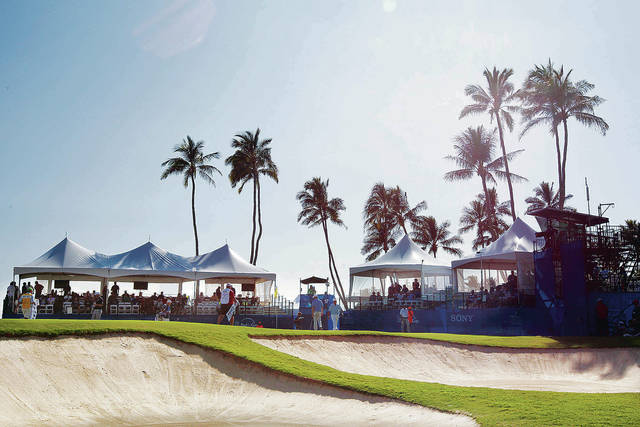There has been a lot of talk about the changes at the No. 6 and 17 greens this week, and not all of it good. Just don’t count Tony Finau on the negative side of the equation, not after he aced the 17th during Saturday’s third round of the Sony Open in Hawaii.
Finau said if he hadn’t put a lot of height on the ball that “no way was it going to stop on that green. I think most of the complaints on that green is the ball doesn’t stop.”
Part of the reason for the recent changes is that Waialae Country Club is undergoing a facelift of sorts, only this one is meant to make everything new old again. NBC and Golf Channel analyst Mark Rolfing discussed the matter earlier in the week and said the recent alterations are to return the course to the way it was when it was unveiled in 1927 by designer Seth Raynor.
Raynor disciple Tom Doak was tasked to make the green on No. 6 more like the original punchbowl shape of nearly 90 years ago. The par-4, 460-yard hole has the prevailing trades moving left to right across the fairway. It’s easy to go out of bounds on the right with a poor drive. It’s best to be left-center to remain away from a fairway bunker and trees. There is also a bunker guarding the front right, making this a tough hole.
On the first day, it was ranked the second-hardest, surrendering 18 birdies among 144 golfers. There were also 35 bogeys and five double bogeys. On Friday it was equally difficult, coming in as the second-hardest for the second straight day and the toughest overall through 36 holes with only 25 birdies in 287 rounds of golf. It was tied for the fifth-hardest hole on Saturday, surrendering 15 birdies, including one from veteran golfer Zach Johnson.
The 2009 Sony Open champion has been vocal about the changes and his review is not a good one.
“I’m not very fond of the changes,” Johnson said. “But there’s not a player in the field who would say otherwise. If they did, they’re lying; 100 percent they’re lying. Not the rookies, but if they’ve seen it … ”
The par-3 17th came under close scrutiny, as well. Rolfing said the redesign there was probably in the fourth of an eight-year process. The Maui resident scratched a picture on the back of a piece of paper that reflected most of the golfers will be aiming at the sponsors’ skyboxes guarding the left side of the green and taking a free drop if necessary. Going right is just not an option there.
The par-3 played 178 yards on Saturday — it was ranked fourth. On Thursday, it was the fourth hardest with 17 birdies and eighth hardest on Friday with 29 birdies and 33 bogeys. Rolfing said in four years when the green redesign is completed, it should be fine. Until then, he recommends moving the skyboxes to the right side of the green facing the ocean.
As for the players, world No. 2 Jordan Spieth put it this way.
“I’ve played it well, so far,” Spieth said of 17. “I’m 1 under the first two days. I thought the old one was a really, really great par-3. I think this one requires a bit of luck. That’s never really fun. It’s a better hole into the wind (Friday), but that’s not the dominant wind.
“With the new green, you can still play it to a spot where you have an advantage over the field if you’re smart off the tee. So, I’ve got no problem looking at it that way.”
Second-round leader Brian Harman offered this take.
“I think they had the right idea in most places,” Harman said. “It’s just — it’s so new. I need a couple more years to see how it kind of settles in before I can make a … I don’t think anyone can walk up on the green the first year it has changed and say, ‘Oh, this is markedly better or markedly worse.’ It takes time for the grass to settle and for the hills to settle and see how it’s going to play.”
Sony Open Notebook by Honolulu Star-Advertiser on Scribd

